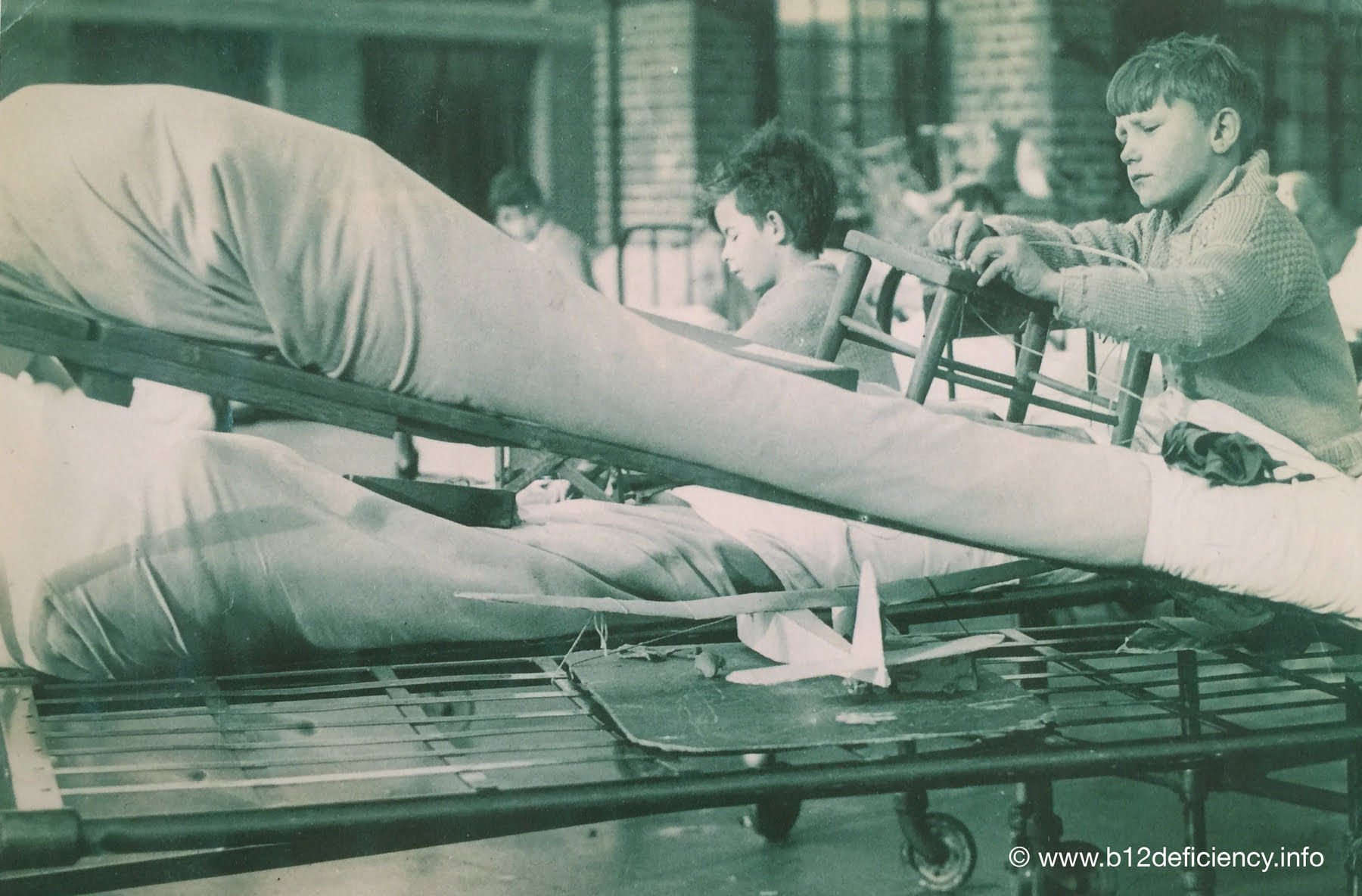This little fella spent a long lime in hospital as a child following a diagnosis of Perthes disease (Legg-Calvé-Perthes disease). Perthes is a childhood hip disorder caused by a disruption of blood flow to the ball of the hip joint.
By the time he was 30 years old he had suffered his first heart attack.
He died aged 37 following his third.
Just prior to his first heart attack he experienced intense jaw pain whilst digging the garden and his face drained of colour. In between the 2nd and 3rd attacks he experienced flu-like symptoms but no chest pain and none of the other classic symptoms associated with heart attack. These details were a surprise to me and may be to you too.
This handsome young man was my dad and I inherited many things from him including his hair, a love of woolly jumpers and furniture making skills. (I don’t make a habit of keeping model aeroplanes under my bed though).
Amongst those interesting traits, I also inherited a clotting disorder; Factor V Leiden (FVL) and a myriad of genetic polymorphisms many of which are connected to B12 and folate methylation. (MTHFR, MTRR, MTR,CBS, and BHMT, to name a few).
No one knew why my dad had heart attacks and died so young and it has long remained a mystery, apart from his limp left over from Perthes disease, he appeared to be a fit and healthy young man.
I learned that I had FVL when I was trying to conceive and found that Perthes’ disease also has a connection to FVL. (see refs below).
With the help of genetic testing and the unravelling of my own medical history since being diagnosed as B12 deficient, there are now clear indications of my dad’s underlying B12 and folate methylation problems.
These coupled with an undiagnosed clotting disorder could have contributed to – or could perhaps be the cause of his death? I wouldn’t mind betting that he had a sky-high homocysteine level but it’s doubtful that testing for this would have been on any radar and even today it’s tricky (if not impossible) to persuade a GP to test.
High homocysteine is known to be strong risk factor for cardiovascular disease, it is a an amino acid which rises to a toxic level in patients with low, B12, B6 and B9 (folate). If a high homocysteine level is present and the patient also has FVL then research shows there is an even greater risk of Cardiovascular problems.
I was thankful that the GP I saw upon diagnosis of my B12 deficiency seemed to understand the problems associated with FVL and low B12 and I was reassuringly told -‘We’ll have to look after you’. Sadly this statement was quickly forgotten and the silly games regarding strict rationing of life giving B12 injections began.
I contacted many cardiologists to invite them to the conference we held in May but there was a total lack of interest. They receive millions of pounds in research grants but they don’t appear to want to look at the basics. It is a crying shame they didn’t hear Sally Pacholok and Malcolm Kendrick speak, but when their research money comes from pharmaceutical companies I expect they feel their hands are tied.
On health questionnaires we are often asked if we have a history of certain conditions, it seems that with a shrug of the GP’s shoulders, you must understand that you may succumb to heart attack, Alzheimer’s, or bipolar if they are prevalent conditions in your family (they are in mine). That you just have to take it on the chin and await what comes your way.
Many of us who read and research B12 deficiency, join up the dots early. We know that these conditions and many more can all be related to low B12 and that if we are given vital B12 injections at the frequency we need then we can live healthily and happily. We may also feel that the outcome for many of our loved ones might have been different had the full knowledge of B12 deficiency been available to the clinicians in charge of their care.
We want our doctors to discover and understand this too so we send them journals, advise them to read ‘Could it be B12?’ We lay the facts out in black and white, but we are often ignored, ridiculed and neglected. We understand that this action of trying to educate is irritating to doctors but what else can we do?
We are fighting for our lives whilst we wait for the medical community to catch up.
To see who is at risk of B12 deficiency, please click here https://www.b12info.com/who-is-at-risk/
Raising awareness; https://www.b12info.com/how-you-can-help/
Best wishes, Tracey
Ann Intern Med. 1997 Nov 15;127(10):895-903.
Factor V Leiden mutation and the risks for thromboembolic disease: a clinical perspective.
Price DT1, Ridker PM.
http://www.ncbi.nlm.nih.gov/pubmed/9382368
J Orthop Res. 2014 Jan;32(1):1-7. doi: 10.1002/jor.22473. Epub 2013 Aug 27.
Meta-analysis of hypercoagulability genetic polymorphisms in Perthes disease.
Woratanarat P1, Thaveeratitharm C, Woratanarat T, Angsanuntsukh C, Attia J, Thakkinstian A.
http://www.ncbi.nlm.nih.gov/pubmed/23983171
J Bone Joint Surg Am. 2004 Dec;86-A(12):2642-7.
Legg-Calve-Perthes disease and thrombophilia.
Balasa VV1, Gruppo RA, Glueck CJ, Wang P, Roy DR, Wall EJ, Mehlman CT, Crawford AH.
http://www.ncbi.nlm.nih.gov/pubmed/15590848
Acta Orthop Belg. 2007 Oct;73(5):612-7.
Thrombophilia and Legg-Calvé-Perthes disease: is it a causative factor and does it affect the severity of the disease?
Moens P1, Defoort K, Vancampenhout A, Peerlinck K, Fabry G.
http://www.ncbi.nlm.nih.gov/pubmed/18019917
J Pediatr Orthop. 2007 Oct-Nov;27(7):834-7.
Legg-Calve-Perthes disease, venous and arterial thrombi, and the factor V Leiden mutation in a four-generation kindred.
Glueck CJ1, Tracy T, Wang P.
http://www.ncbi.nlm.nih.gov/pubmed/17878795
Thromb J. 2014 Dec 16;12(1):30. doi: 10.1186/s12959-014-0030-0. eCollection 2014.
Severe hyperhomocysteinemia due to cystathionine β-synthase deficiency, and Factor V Leiden mutation in a patient with recurrent venous thrombosis.
Awan Z1, Aljenedil S2, Rosenblatt DS3, Cusson J4, Gilfix BM2, Genest J5.
http://www.ncbi.nlm.nih.gov/pubmed/25516723
Clin Chem Lab Med. 2003 Oct;41(10):1357-62.
The risk of venous thromboembolism associated with the factor V Leiden mutation and low B-vitamin status.
Obeid R1, Hakki T, Jouma M, Herrmann W.
http://www.ncbi.nlm.nih.gov/pubmed/14580166
J Med Assoc Thai. 2000 May;83(5):536-42.
Association between serum homocysteine, vitamin B12, folate and Thai coronary artery disease patients.
Leowattana W1, Mahanonda N, Bhuripunyo K, Pokum S.
http://www.ncbi.nlm.nih.gov/pubmed/10863900
Mini Rev Med Chem. 2012 Sep 1;12(10):997-1006.
Role of polymorphisms in factor V (FV Leiden), prothrombin, plasminogen activator inhibitor type-1 (PAI-1), methylenetetrahydrofolate reductase (MTHFR) and cystathionine β-synthase (CBS) genes as risk factors for thrombophilias.
Miranda-Vilela AL1.
http://www.ncbi.nlm.nih.gov/pubmed/22512572


Hello Tracey
I would really like to read some of the comments left here but cannot find them. I myself left a comment some months ago and cannot find it either. Could you send me a LINK maybe?
Thanks,
Bonnie
Hi Bonnie, please see this link for your comment http://www.www.b12deficiency.info/blog/2015/07/29/understanding-what-it-feels-like-to-be-b12-and-folate-deficient/#comment-144650
You will find the comments on the right hand side bar.
Thanks Tracey
Very interesting. I have been diagnosed with possible PA due to parietal cell antibodies and have the prothrombin mutation.